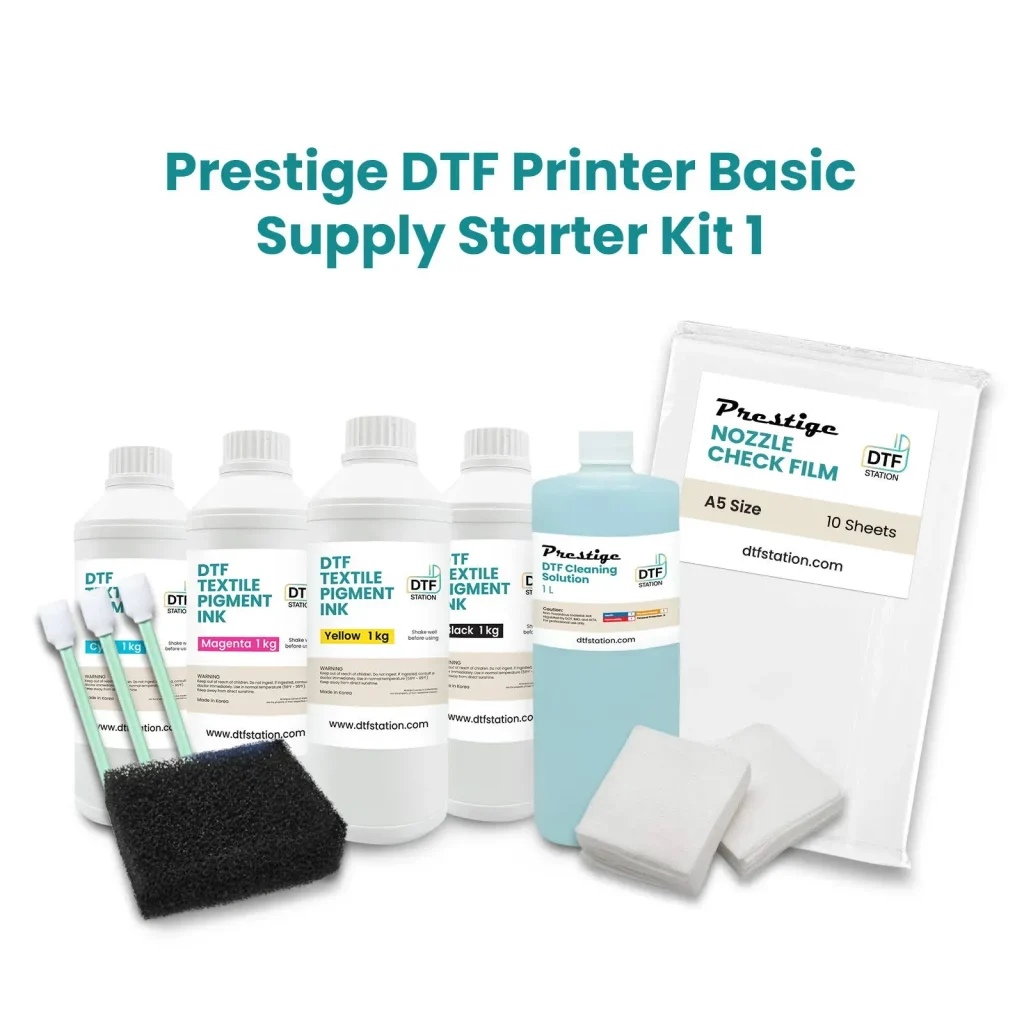In the competitive realm of custom apparel and textile printing, DTF supplies have become essential tools for creators looking to elevate their craft. DTF, or Direct to Film, printing allows for stunning, high-definition transfers that adhere beautifully to a variety of fabrics, capturing vibrant colors and intricate designs. To achieve the best results, understanding the pivotal elements of DTF supplies—including transfer film, DTF inks, adhesive powder, and a reliable heat press—is crucial. This innovative technique is not only streamlining the transfer process but also enhancing the durability and wearability of printed garments. Join us as we delve deeper into what you need to know about DTF supplies to create professional-quality prints that make a lasting impression.
Whether referred to as Direct to Film printing or simply DTF, this modern method of transferring designs onto fabric has transformed the printing landscape. Key components like specialized printing films, ink formulations, and heat application techniques play an integral role in the success of this process. Importantly, the use of high-quality adhesion powders ensures that your designs firmly bond to various textiles, allowing for both visual appeal and longevity. Understanding the nuances of these essential materials is vital for anyone looking to excel in custom garment production. As we explore these supplies further, you’ll discover how they work in harmony to produce exceptional results in the world of fabric printing.
Understanding DTF Printing Techniques
DTF printing, or Direct to Film printing, is a relatively new method revolutionizing the custom apparel industry. Unlike traditional screen printing, DTF allows for vibrant designs that can be applied to a variety of fabrics including cotton, polyester, and blends. The process begins by printing a design onto a special transfer film using specialized DTF printers. These printers use high-quality DTF inks which are often water-based, allowing colors to remain bright and true to the design.
Once the design is printed on transfer film, it is coated with adhesive powder before being heat pressed onto the garment. This method guarantees that the color adheres well to the fabric, resulting in durable and vivid prints. Compared to other printing methods, DTF is advantageous for small runs and complex designs, making it a preferred choice for custom apparel businesses.
Choosing the Right DTF Supplies
When embarking on your DTF printing journey, the first step is selecting the right DTF supplies. Start with a specialized DTF printer that is compatible with DTF inks to ensure a smooth printing process. Brands like Epson offer printers that are ideal for this purpose, providing exceptional color quality and detail.
Additionally, investing in high-quality transfer film and adhesive powder is crucial for achieving professional results. The effectiveness of your DTF setup considerably depends on the interaction between the film, inks, and adhesive, which together facilitate a successful heat transfer.
The Importance of Transfer Film in DTF Printing
Transfer film is a critical component of the DTF printing process. It serves as the medium onto which your designs are printed and must withstand the heat and pressure of the transfer process without losing integrity. High-quality DTF transfer film is designed specifically to facilitate optimal ink adhesion, ensuring your prints maintain their vibrancy and detail when transferred to fabric.
Choosing the right type of transfer film can also impact the overall durability of your prints. Films that are engineered for DTF applications typically exhibit better performance than generic alternatives, providing a smoother transfer and longer-lasting results on garments.
Selecting DTF Inks for Vibrant Prints
The choice of DTF inks is instrumental in achieving vivid and durable prints. DTF inks are often pigment-based and water-soluble, offering a wide color gamut and excellent adhesion to the transfer film. It is important to ensure that the inks you select are specifically formulated for DTF printing to avoid issues such as clogging and poor color output.
Different types of DTF inks may also require different settings on your printer. Each type is engineered to behave differently based on the environmental conditions and the transfer film used, making it essential to conduct thorough testing and calibration to achieve optimal results.
Maximizing Output with a Heat Press
A high-quality heat press machine is vital for effectively transferring DTF prints onto fabrics. The configuration of temperature, pressure, and timing must be meticulously adjusted to match the specific materials being used. An inconsistent heat press can lead to subpar transfer results, including poor adherence or image distortion.
Investing in a reliable heat press not only enhances the quality of your prints but also streamlines your workflow. With the right settings and a sturdy machine, you can achieve consistent results across different projects, boosting your overall productivity and print quality.
Cleaning and Maintenance for DTF Supplies
Proper maintenance and cleaning of your DTF supplies are essential to ensure optimal performance and longevity of your equipment. Cleaning solutions designed for DTF printers are necessary to keep ink nozzles free from clogs, which can otherwise compromise print quality and result in costly downtime.
Regular maintenance routines, including thorough cleaning of the printer, heat press, and workspace, can drastically improve the consistency of your output. Establishing a cleaning schedule helps maintain your equipment in peak condition, ultimately leading to superior prints and a more efficient printing process.
Frequently Asked Questions
What are the essential DTF supplies needed for successful printing?
To start with DTF printing, you’ll need a specialized DTF printer, high-quality transfer film, DTF inks, adhesive powder, and a reliable heat press. Each component plays a pivotal role in ensuring vibrant and durable transfers onto fabric.
How does transfer film affect DTF printing quality?
The transfer film is crucial in DTF printing as it ensures proper ink adherence during the heat transfer process. Choosing high-quality transfer film specifically designed for DTF applications will maximize print quality and durability.
What type of DTF inks should I use for printing?
You should use water-based and pigment-based DTF inks specifically formulated for DTF printing. These inks provide vivid colors and long-lasting results, while compatibility with your DTF printer is essential to prevent clogging and ensure color integrity.
Why is adhesive powder important in the DTF transfer process?
Adhesive powder is vital in DTF printing as it helps bond the printed ink to the fabric during the heat transfer process. Using high-quality adhesive powder ensures a smooth transfer and enhances the longevity of your prints.
How do I choose the right heat press for DTF printing?
Selecting a reliable heat press is crucial for DTF printing. Look for features such as adjustable temperature and pressure settings, suitable for the types of fabrics and adhesive powders you will be using, to ensure optimal results.
What maintenance is required for DTF printing supplies?
Proper maintenance of your DTF printer and supplies is essential. Use cleaning supplies designed for DTF printers to keep nozzles clear and prevent ink clogging, ensuring consistent quality in your prints.
| Key Point | Description |
|---|---|
| DTF Printing | Direct to Film printing allows for vibrant and durable prints on a variety of fabrics. |
| Specialized DTF Printers | Reliable DTF printers, typically from brands like Epson, are essential for quality printing. |
| Transfer Film | High-quality transfer film designed for DTF printing ensures proper adherence of ink. |
| DTF Inks | Water-based and pigment-based inks that provide vivid color and are printer compatible. |
| Adhesive Powder | Applied to wet ink, it helps adhere the design to fabric during heat transfer. |
| Heat Press Machine | Correctly adjusted heat press settings are crucial for quality transfers. |
| Cleaning Supplies | Cleaning supplies for DTF printers ensure optimal functionality and print quality. |
| Textile Pre-Treatment | Pre-treatment can enhance transfer durability on various fabrics. |
Summary
DTF supplies play a crucial role in the quality of your prints. To achieve professional-grade results in textile printing, investing in the right equipment—from specialized DTF printers to high-quality transfer films and adhesives—is essential. Each component contributes significantly to the vibrancy and durability of your designs on fabrics. By selecting the best materials and ensuring compatibility with your printer, you can consistently produce outstanding transfers. Furthermore, maintaining a clean workspace and performing regular calibrations will enhance the overall quality of your prints. In summary, understanding and utilizing proper DTF supplies is the foundation of successful DTF printing.



